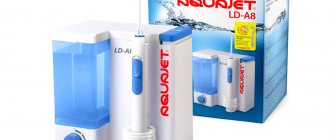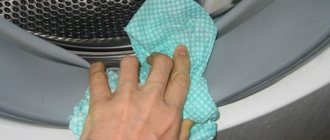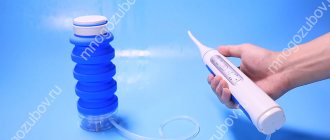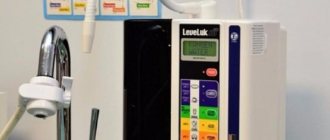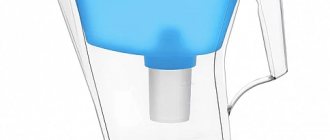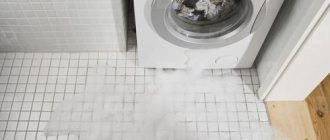613
Careful oral hygiene is one of the main requirements when treating with braces.
No matter how perfect the shape of the locks, they inevitably collect food debris around them, which is very difficult to completely remove with a toothbrush.
In the presence of such a fertile environment, cariogenic bacteria need only a few hours to begin to actively multiply.
Why is it important to use an irrigator when wearing braces?
You should know! An irrigator is a device designed for professional oral hygiene.
It cleans gums and teeth using a strong stream of water or medication.
The device usually contains one or a pair of pumps that draw liquid and mix it with air to form microbubbles.
They carefully knock out food debris and clean braces without damaging the system, regardless of model and type.
In addition, gum bleeding is reduced, unpleasant odors disappear, pathogenic microorganisms are destroyed, and the appearance of tartar and periodontal disease is prevented .
This procedure is much more effective than brushing your teeth with a regular brush or floss, which do not always cope with complex tasks.
When using an irrigator, there is a risk of gum damage, so cleansing should be done with caution, adjusting the jet power to a comfortable level.
Advantages of the irrigator
Waterpik irrigators are effective devices for thorough and gentle oral hygiene when wearing orthodontic and orthopedic structures. In terms of its functionality, this device is the best; it shows high performance, similar to the combined use of a dental brush and floss.
An irrigator for cleaning braces is:
- Professional oral cleaning in the comfort of your own home.
- Thorough cleaning of interdental spaces, areas under brackets and arches of structures, places where braces connect to the gums.
- A jet of water under pressure cleans teeth and gums well from plaque and food debris, without destroying tooth enamel or injuring the gums.
- Using nozzles, you can direct a stream of water to the desired location, exerting a targeted effect on each element of the dental structure. Before cleaning your braces, you need to select the optimal pressure force of the washing liquid.
- A pulsating stream of water gently massages and strengthens the gums, preventing their bleeding and the formation of inflammatory processes.
- Gentle effect. Bracket systems made of ceramic or plastic, models with decorations, are quite fragile structures that require special care. Using an irrigator, you can thoroughly and carefully clean all elements without the risk of damaging them.
Types of devices for braces
To figure out which device is better to choose, let’s determine the main types of devices on the market. There are three main types of irrigators: flow-through, portable and stationary models.
Flow devices
Note! Flow-through irrigators do not have a water reservoir. The device is connected directly to the water supply using a special faucet attachment.
Some models have additional compressors, but no electrical mechanisms. The water pressure from the tap is enough for them.
Advantages:
- large volume of liquid;
- no need to prepare water in advance;
- no need to recharge the battery;
- the irrigator is equipped with a modern filtration system, which minimizes the effect of chlorine on the mucous membrane, which is harmful to the body;
- simple installation of the device;
- strong fixation with a bracket.
Note! Among the disadvantages of such a device are:
- water supply in a single mode;
- it is impossible to connect the system to a non-standard tap;
- the use of rinse aid is not provided;
- the filtration system does not remove all impurities contained in tap water;
- frequent filter changes.
Portable irrigators
In appearance, the portable device is similar to an electric toothbrush.
The water compartment is located in the handle , the volume is small (about 200 ml).
The device runs on batteries.
Advantages:
- possibility of using rinse aid;
- water preparation using a filter;
- the system is compact and does not take up much space;
- replaceable nozzles;
- a bag-case for storing the irrigator is included;
- suitable for travel and home use;
- affordable price.
Stay up to date! The disadvantages of this model are:
- small volume of water, sometimes it is not enough to fully clean your teeth;
- with daily use, the batteries will only last for a month;
- no more than five modes;
- weak water pressure;
- weight: when filled, the device weighs 500 g, which makes it inconvenient to use.
Stationary models
The most popular today are stationary models.
The device consists of a tube, a handle, nozzles and a water container. The system runs on battery power.
Keep in mind! The advantages of such a device are:
- high power;
- use of many cleansing modes;
- high water pressure;
- powerful battery, the device can work for several hours without interruption;
- water filtration;
- In one procedure, you can simultaneously brush your teeth and perform a therapeutic massage of your gums.
Flaws:
- when using unfiltered water, the system will quickly fail;
- impressive size of the device body;
- it is necessary to monitor the water level.
General concept
Of all the devices for caring for teeth while wearing braces, dental irrigators stand out in a special place in terms of functionality, variety of types and considerable price.
The operating principle of the devices is based on creating a thin, strong stream of water, which knocks out food debris from all the hidden places of the braces system.
The jet is created either by water pressure in the water supply (in flow-through irrigators), or by the action of a pump powered by mains voltage, accumulator or batteries.
In general, the irrigator consists of the following elements:
- handle with a button to turn on the water supply.
- various attachments installed in the handle;
- energy source for the pump (batteries, accumulator, power cord for connecting to the network);
- water supply hose;
- built into the device itself or a separately located water container (not available for flow-through irrigators).
The pump can be built into the container (for stationary models), into the handle itself (for portable irrigators) or absent altogether (for flow-through ones). Pumps create different pressures. For stationary ones - up to 900 kPa, for portable ones - up to 500 kPa. The pressure of the jet created by the flow structure depends on the pressure in the water supply.
Irrigators provide an increased degree of cleaning of braces compared to conventional rinses or toothbrushes. It is determined by the following operating features of the devices:
- The pressure of a thin jet knocks out pieces of food from secluded narrow places inaccessible to brushes and pipe cleaners.
- Its direction and nature of supply may change when using different operating modes and using different nozzles.
- Water with deodorizing and antiseptic properties can be used for cleaning.
- With the help of an irrigator, you can not only clean braces, but also massage your gums, clean dentures and implant structures, remove soft plaque, and carry out medical procedures.
- One device with a set of individual attachments can be used by all family members.
Before buying a specific model of irrigator, it is advisable to become familiar with the differences between different designs and for what operating conditions they are intended.
Important. Despite the versatility of irrigators, they are still designed to work in conjunction with other devices, mainly with a regular toothbrush, and alone cannot ensure ideal cleanliness of braces.
Model range of ODP braces and technologies used in production.
Come here to review the properties of orthodontic silicone for braces.
At this address https://zubovv.ru/ortodontiya/breketyi/vestibulyarnyie/kombinirovannyie-universalnoe-reshenie.html we will discuss the pros and cons of combined braces.
Which one is better to choose: criteria
Important! When buying an irrigator for braces, first of all you need to pay attention to the jet flow modes. The pulsating mode is considered mandatory - it is most effective for braces.
Thanks to pulsation, hard-to-reach areas can be easily cleaned without damaging the installed system.
also worth taking a closer look at the mode with microbubble technology - it saturates the water with oxygen, has an antibacterial effect and effectively cleanses the oral cavity of plaque.
In normal mode, the jet is supplied in a continuous stream; this mode is available in any irrigator.
However, it will not clean your braces properly.
What attachments must be included in the kit to clean braces?
The device for cleaning braces comes with various types of attachments. Each of them has its own purpose.
Standard – small hole and smoothly curved neck. Covers 1-2 teeth. Does a good job of cleaning braces.
It is worth noting! The orthodontic nozzle cleans all types of structures, including braces.
Sanitizes interdental areas and joints between teeth and gums. The neck has a narrowed tip and the tube is elongated. The pressure is strong, the stream is thin.
Massage – the nozzle is equipped with bristles, the head is rounded. Regenerates the mucous tissues of the oral cavity after surgical interventions, relieves pain, improves blood circulation.
Makes getting used to the corrective device quicker and less painful.
Periodontal – a nozzle with elastic bristles.
With its help, the liquid penetrates into the periodontal pockets and beyond the gingival margin, carefully cleaning plaque from the teeth and braces.
Instructions for use
Before using the irrigator, it is necessary to properly prepare it . To do this, the container is filled with water purified from impurities at room temperature.
If you are using the device for the first time, you need to clean it additionally by passing the entire volume of water in standard mode through the nozzle. Then the liquid supply speed and the desired mode are adjusted.
Remember! Teeth cleaning with braces installed is carried out in several stages:
- Cleansing the oral cavity is carried out by bending over a sink into which water will flow during the procedure;
- the mouth is slightly opened, the nozzle is directed towards the teeth, starting with the last molars;
- First of all, they clean each brace, paying special attention to the lock and the place where the braces adhere to the enamel;
- the jet is directed directly to the gum line and interdental spaces;
- then the remaining surface is treated.
At the end of the procedure, it is recommended to perform a light periodontal massage using a water jet.
Instructions for use
Before you start using the irrigator, you need to check it. The container is filled with boiled warm water, and all the liquid is released in a continuous stream.
If everything is normal with the operation of the device, water is prepared for it or it is connected to the water supply. After this, the device is ready for use.
When first used, the jet pressure should be kept small, especially with inflamed gums. During the cleaning process, it can be increased if no discomfort occurs.
The general cleaning procedure is as follows.
- A person leans over the sink, opens his mouth slightly so that water can flow freely, turns on the irrigator and directs the stream to the braces.
- Cleaning begins from the distal sections, gradually moving to the front.
- First, the clasps are cleaned, then the gum line, and finally the interdental space.
- After all the locks have been passed, the jet is directed to the remaining areas of the oral cavity.
- The procedure ends with a massage of the gums using a massage attachment.
The device must be used in strict accordance with the instructions; the stream must not be directed into the nose, ears, or eyes.
After cleaning, all used attachments must be dried and stored in their compartments. If the battery or batteries are discharged, the first one must be charged, and the batteries must be replaced.
In the video, a specialist explains how to use the irrigator correctly.
TOP models
Important! For comprehensive oral care, you need to choose a good irrigator.
We invite you to familiarize yourself with the rating of the best devices in terms of price and quality:
- Oral-B Professional Care Oxy Jet MD-20 . Smoothly adjustable jet power, large tank, four nozzles included. Circular spray mode, affordable price.
- Shenzhen Fortunecome Technology FL-V8 . Stepwise adjustment of jet pressure, three modes, two nozzles included. Charging via cable.
- Panasonic EW 1211 A. Multi-bubble technology, three modes. Wireless charging, compact.
- Device WaterPik WP-660 Aquarius Professional . Has two modes, powerful jet pressure. There are 7 nozzles and a large volume of water tank. Speed control is smooth, the nozzle rotates 360 degrees, safe to use.
- Philips AirFloss Ultra HX8432 . Spacious container for water or rinse aid, built-in battery. Injection function and spray mode, ergonomic design, power.
- Irrigator Donfeel OR-840 AIR. There are 4 attachments (orthodontic, jet, periodontal, tongue cleaning), 10 modes. Magnetic innovative attachment attachment. Quiet in operation.
- Device AQUAJET LD-A8 . Has 5 nozzles included, smooth speed control. It is compact and inexpensive.
Keep in mind! This device is not a replacement for floss and toothbrushes, but an additional tool for professional oral hygiene.
Flow irrigators
A special feature of flow-through devices is that they are connected directly to the water supply; they do not have a built-in reservoir for various liquids. Some models do not even have electrical mechanisms - the pressure of tap water is enough for them to work. Flow irrigators have the following advantages:
- continuous operation of the device, no need to stop the hygiene procedure in order to refill the water container;
- the water does not need to be filtered in advance - the filter built into the design of the unit will cope with excess chlorine in tap water;
- compact size of the device;
- There is no need to worry about the batteries or accumulator running out – they are simply not in the device. The entire structure operates using water pressure from the tap.
With all the advantages, portable irrigators also have disadvantages: you cannot use rinse aid or other liquids; the water pressure is not regulated by the force of impact; the device requires regular replacement of filters in the design and the filters cannot cope with all harmful impurities; if the tap is non-standard, it may happen that the flow irrigator cannot be connected.
Reviews
Below are some customer reviews. If you have something to say, leave your feedback in the comments below the article, it will be useful to our readers.
Natalya Ershova.
After installing braces, the dentist recommended purchasing an irrigator. I chose a landline and have never regretted the purchase.
The system copes with the task perfectly: the teeth are clean and healthy, without a hint of caries, the gums have stopped bleeding, and the braces are not damaged.
Kristina Zakharova.
I have been using the irrigator for several years now. I have it with a sprayer. Works from a power outlet, convenient to use in the bathroom.
I fill it only with filtered water - it’s safer and will last longer.
The irrigator helped a lot while wearing braces; after each meal, there was no need to clean with brushes and flosses, you just had to quickly run the jet over your teeth and everything was clean in literally a minute.
After removing the braces, I did not give up the device, I massaged my gums and their condition improved significantly.
Useful video
From this video you will learn how to use an irrigator while wearing braces:
An irrigator is an indispensable assistant if you have braces . In addition to thorough cleaning, it improves the overall condition of the oral cavity and is one of the modern preventive methods for dental health.
When purchasing a device, carefully study all types of irrigators and find out the cleaning technique; this will help you make the right choice and make the procedure enjoyable.
How to use and clean teeth with braces with an irrigator
Video about how an irrigator is used with braces:
The steps for cleaning braces, teeth and gums are as follows:
- Fill a container with warm water.
- Select the appropriate mode. It is recommended to start with the lowest power, gradually increasing it to the desired parameters.
- Move the nozzle to the teeth at an angle of 45º and turn on the liquid supply.
- Treat the entire space of braces, teeth and gums. On average, about 2-3 minutes should be spent on all hygiene.
- Finally, rinse your mouth with an antiseptic solution.
You need to use the irrigator at least twice a day, morning and evening. However, if you have braces, cleaning can also be done after every meal to better clean hard-to-reach areas.
